

Usetiful is a cloud-based digital adoption platform that aims to help you boost user engagement and product adoption.
It's a very affordable product, but is it the best onboarding platform for your specific needs?
This article will review the benefits and disadvantages of Usetiful and 7 of its competitors to help you answer that question.
What Usetiful does well
Very affordable
If you're a small business or a startup with a limited budget, Usetiful's pricing is very appealing.

They offer a free pricing tier for up to 2000 assists per month. Usetiful defines an assist as "when a user is actively helped by Usetiful."
At €29 per month (paid annually), which is about $31.50 per month, Usetiful's Plus tier costs about 1/10 of the average price of competitors.
Even its Premium tier, at €69 per month ($75), is extremely competitive.
Knowledge base
Usetiful recently added a knowledge base feature to their tool.

This allows your users to find answers to their own questions independently, reducing the need for you to retain a large, expensive support team.
If you need to create content to add to your knowledge base, Usetiful's WYSIWYG editor is intuitive to use and will make this easy for you.
Simple product tours
Usetiful's product tours are known in the SaaS community for being particularly easy to set up. Here's what a G2 user said about them:

They support a wide variety of triggers, allowing you to create product tours that cater to a range of different use cases.
For each use case, the visual pathway you can create with a Usetiful product tour is clear and easily navigable for your customers.
Drawbacks of Usetiful
Limited customization
Compared to the other tools in this article, Usetiful offers limited customization options for colors and fonts, which can make your UI look a bit cheap.
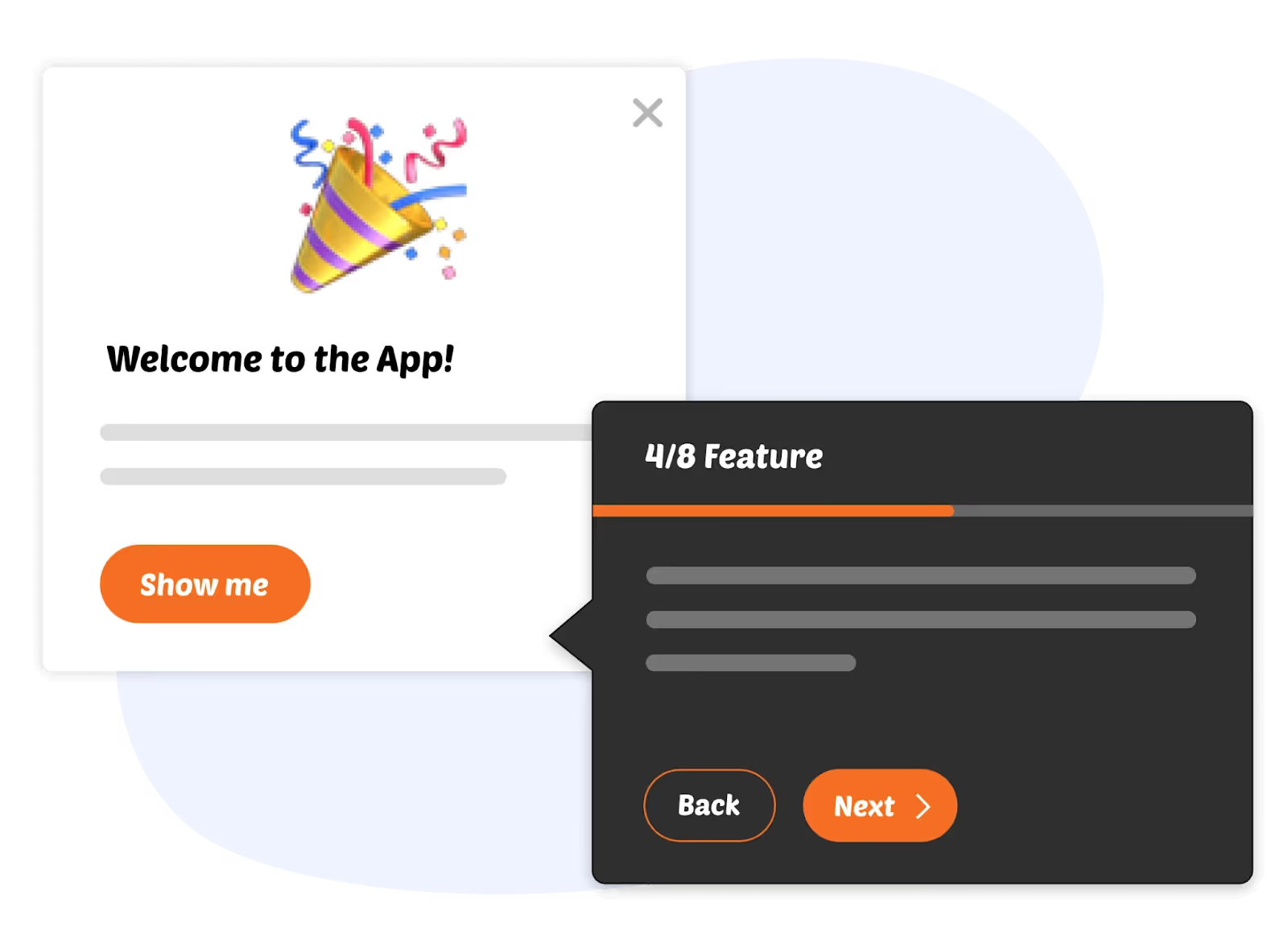
The main problem here seems to be that Usetiful will only let you customize your onboarding elements at the level of your theme:
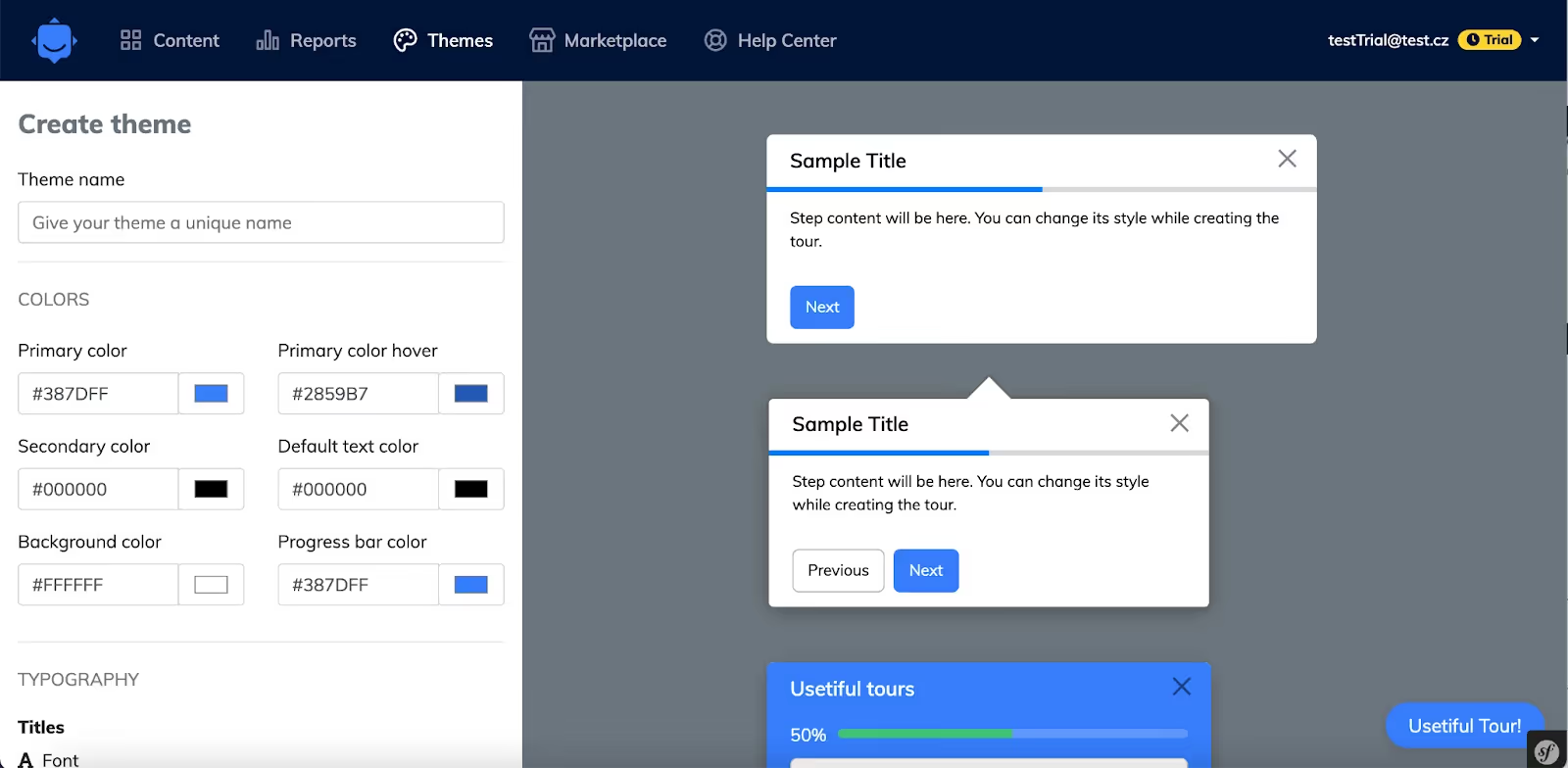
If you want to experiment with different color schemes for different use cases, or run A/B tests with colors or fonts, that might be challenging with what Usetiful can offer.
Limited configuration of onboarding materials
Since Usetiful is so cheap, it stands to reason that the depth of their onboarding elements is less extensive than those on other platforms.
The following features are limited in scope on Usetiful:
- Segmentation
- Scheduling
- Rate limiting
- Custom triggering options, such as JavaScript commands
Additionally, they lack a product updates feature, and their survey offering is limited to NPS and is only available as a reaction step to viewing a guide.
Very limited analytics
Usetiful's analytics solution is limited to basic material interactions. For example, you can see how many users started or completed a particular in-app experience.
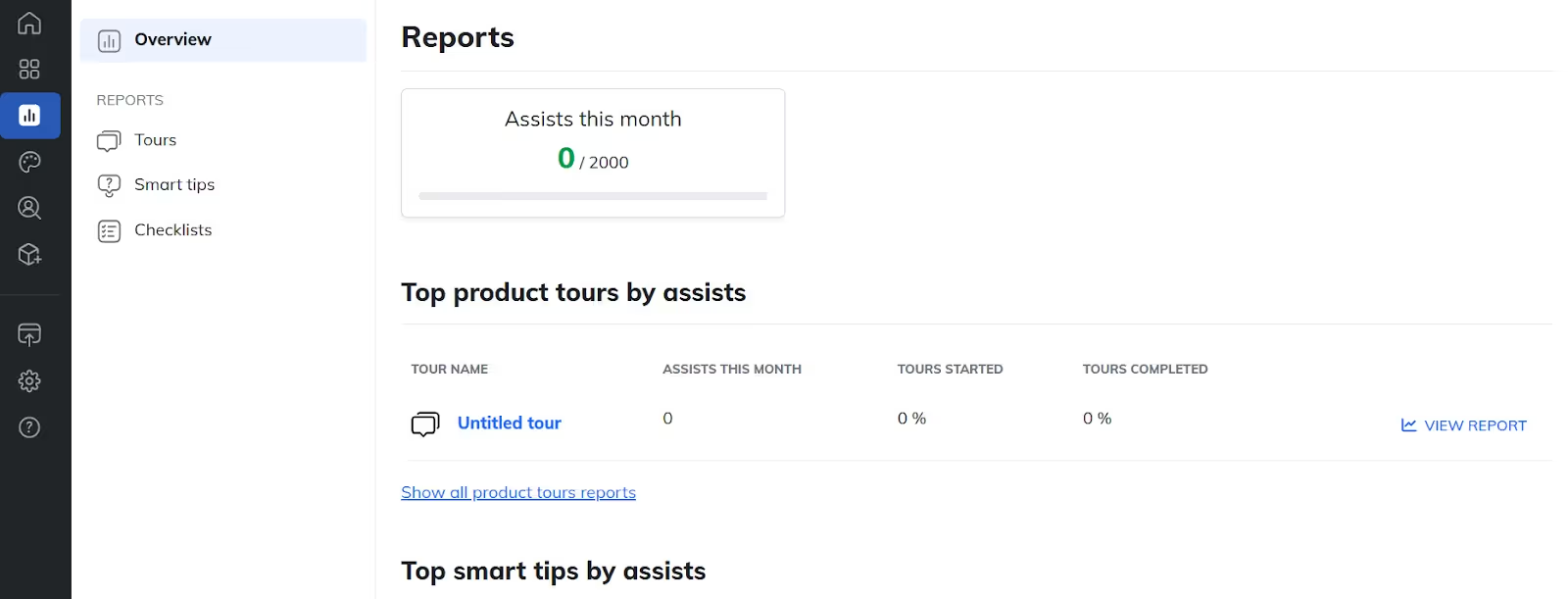
If you have one of their paid plans, you can see analytics at the level of an individual user. In other words, you can see which in-app experiences an individual user has started or completed.
But what if you want to do a more sophisticated activity analysis?
For example, let's say you want to know how many users from a particular segment who are also from the US and from businesses spending at least $1k a month on your platform completed onboarding for a new feature.
Usetiful's analytics falls short for these more complex use cases, and it's been our experience that these are precisely the sorts of questions you need to ask yourself if you want to maximize your results from your user onboarding.
No SOC 2
Unlike numerous other onboarding apps, Usetiful doesn't have a SOC 2 certification.
If your business is processing a large amount of sensitive data, which is common in industries like healthcare, insurance or finance, this could be a problem.
The fact that Usetiful lacks this certification means that your data is at a higher risk of being hacked and falling into the wrong hands than it would be if you used an alternative solution.
7 Best Usetiful Alternatives
We’ll go over each tool and see how it stacks up against Usetiful.
Let's go!
1. UserGuiding - the all-in-one product adoption platform

- Capterra ⭐4.7/5 (51 reviews)
- G2 ⭐4.7/5 (391 reviews)
UserGuiding is a no-code digital adoption solution that helps you provide better in-app experiences.
It works with a Chrome extension that lets you create various user onboarding elements as an overlay to your product without having to use code.
UserGuiding’s guides are not only easy to install, but also quick to create. It's possible to create and publish a guide in under 15 minutes, improving your customer journey in an instant.
With tooltips, hotspots, announcement modals, checklists, and resource centers, UserGuiding offers powerful features at all pricing tiers – meaning that you don’t have to go over budget in order to retain more customers.
UserGuiding Features
In-app surveys
Userguiding provides powerful in-app surveys that allow you to gather both quantitative and qualitative data about what your users think of a particular feature.
You can even combine multiple different types of questions in one survey or launch different types of surveys for different user segments.
Product updates
Want to share product updates with your customers? With UserGuiding, you can do this easily from inside your app.
Depending on your needs, you can create a dedicated announcement modal, send a UI notification, or add a product update section to your resource center.
Event tracking/user behavior analytics
Sometimes, it can be really helpful to see how specific users or user segments interact with your platform. UserGuiding will let you set specific actions as goals, and then track how many users achieve those goals.
You can track user actions at the individual level as well as on the basis of company-level data, giving you insights into user engagement and performance.
Knowledge Base
UserGuiding comes with a comprehensive knowledge base solution for companies to create and manage support resources. It's easy to deliver these resources both in-app and on a stand-alone hub.
Security
Unlike Usetiful, UserGuiding has a SOC 2 certification. This means that you can be 100% confident that your data is secure from hackers.
Pricing
- On a sliding scale, depending on your number of active users.
- Assuming 2000 MAUs, the Starter Plan costs $174 per month and the Growth Plan costs $349 per month (paid annually). For the Enterprise Plan, you can get a custom quote based on your MAU requirements.
Usetiful vs UserGuiding
2. Shepherd.js - the free, open-source onboarding library
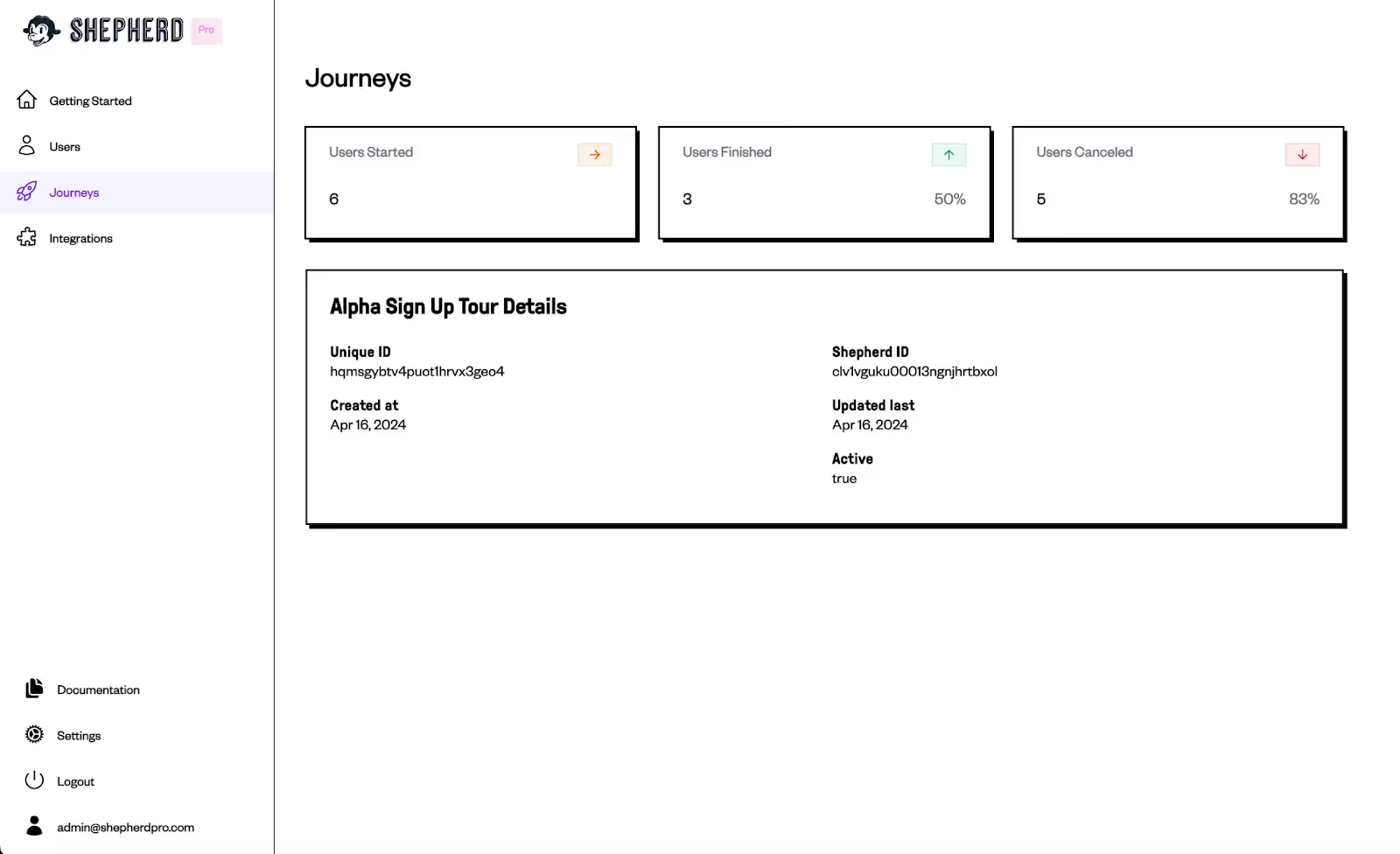
- Github: 13K stars ⭐
- Capterra: no reviews
- G2: no reviews
Shepherd is an open-source JavaScript library for guiding users through your app.
Rather than being a third-party tool like the other options in this list, Shepherd is an open-source library that makes it easier to code simple product tours. This means that you'll need to have technical skills in order to use this product.
The programmers behind Shepherd have also created an enterprise version of their GitHub library called Shepherd Pro. In this version, enterprises can pay to have an expert assist with white glove set-up and on-premise deployment.
Shepherd.js Use Cases
Shepherd.js is a great resource if you have developers on your team with spare time. It's much faster to leverage existing code than to create everything from scratch.
However, it's worth bearing in mind the hourly cost of your developers, together with the opportunity cost of having them work on coding your onboarding instead of working on your core product features.
Pricing
- Free for the majority of users
- If you're an enterprise that needs custom set-up, speak to Shepherd to get a quote
Shepherd.js vs Usetiful
Both Usetiful and Shepherd.js are extremely affordable tools that will add little or nothing to your overhead. Just bear in mind that you'll be paying your developers if you want to build something with Shepherd.js.
Usetiful is a better tool than Shepherd if you want a solution that's low-code and allows you to make simple product tours quickly.
Shepherd is the better solution if you want more customization options and don't mind building your onboarding UX elements yourself.
3. Appcues - powerful, but expensive
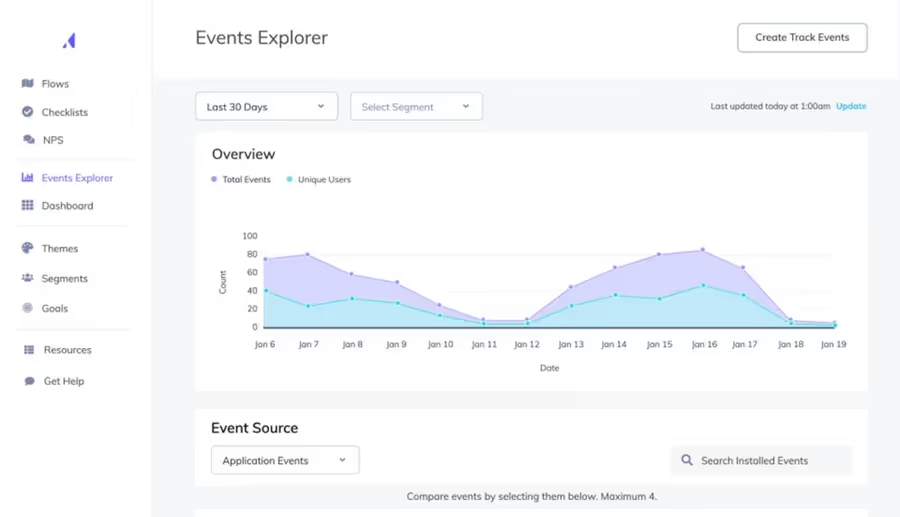
- Capterra ⭐4.8/5 (102 reviews)
- G2 ⭐4.6/5 (305 reviews)
Founded in 2013, Appcues is one of the oldest and most established onboarding apps on the market.
This has given them a lot of time to build a sophisticated onboarding solution with lots of moving parts.
As an older piece of technology, Appcues is a little clunky to install and maintain, especially compared with some of the other tools on this list. But, once set up, the onboarding options it gives you are wide-ranging.
Appcues Features
Appcues' software allows non-technical product managers to build all the typical onboarding features with a minimum of code, including:
- Guides
- Interactive Product Tours
- Tooltips
- Hotspots
- Checklists
They deserve special mention in this list for the quality of their analytics, in particular.
Their Event Explorer feature will let you analyze user events and create tracking dashboards based on your chosen segmentation, without having to code at all. Note, however, that Appcues' analytics are more suited to tracking individual users than they are to tracking data at the company level.
The only meaningful features that Appcues lacks are resource centers and a product updates page.
Pricing
- Sliding scale based on your number of MAUs
- Starts from $279 per month, paid annually
- Custom pricing available for enterprises with more complex use cases
Appcues vs Usetiful
Overall, Appcues is a much better tool than Usetiful – just as long as you can afford it.
Appcues' product adoption features are more powerful, and they offer deeper customization options that accommodate a broader range of use cases.
Appcues' analytics are far deeper than the simplistic analytics offered by Usetiful.
Appcues is also suitable for the mobile onboarding use case, which is becoming increasingly important. Users are incredibly picky about which apps they use on their phones, and an app that doesn't provide a seamless experience will be deleted quickly.
The only area where Usetiful is substantially better than Appcues is price. Usetiful is far cheaper, so it might be the better option for a small business that's just getting started with onboarding and needs a simple solution.
Usetiful also offers a rudimentary resource center feature, which is an improvement on Appcues' lack of resource centers.
Neither tool offers a product updates feature, so if you need that capability, you might want to check out one of the other tools on this list.
4. Whatfix - generalist digital adoption for enterprises, with opaque pricing

- Capterra ⭐4.6/5 (77 reviews)
- G2 ⭐4.6/5 (329 reviews)
Whatfix specializes in providing highly detailed digital adoption experiences for enterprise customers.
Whatfix Features
On the onboarding side of digital adoption, Whatfix allows you to create in-app elements such as checklists, hotspot, guides, NPS surveys and resource centers. You can also make in-app announcements, although there isn't a dedicated product updates page feature.
Rather than focusing on user onboarding, Whatfix has aimed to create a solution that solves all the digital adoption problems of large enterprises. As such, unlike most of the other tools on this list, Whatfix can also help you with employee onboarding and internal training.
If you're rolling out a big piece of new software internally, this could be a great way to make that roll-out smoother.
The fact that Whatfix caters to so many different types of use case is simultaneously a strength and a weakness. It's a strength because there's a certain type of enterprise that is going to see Whatfix and think "this one tool can solve literally all our digital adoption problems."
But it's also a weakness, because Whatfix is so bloated with diverse features and use cases that it makes the role of their support agents almost impossible. Since direct support is very limited, customers often need to rely on only self-serve support articles.
As such, Whatfix consistently has one of the worst customer satisfaction ratings from the tools in this list.
Pricing
- Not disclosed publicly. For a quote, you'll need to contact Whatfix.
- Reviews suggest that pricing is around $1000 a month for access to all features.
Whatfix vs Usetiful
Whatfix and Usetiful are products with vastly different audiences.
Whatfix is completely geared towards the enterprise market in terms of the depth of its features and pricing model. By contrast, Usetiful is geared towards the SME world—the free pricing tier says it all!
Whatfix is more of a generalist enterprise solution than a SaaS product per se. If you need a tool with a broad range of features encompassing digital adoption, employee engagement, and training, Whatfix could be a good investment.
If you need a tool that's more squarely focused on onboarding, Usetiful is the better choice.
5. Userpilot - deep onboarding and product analytics, but not easy to learn
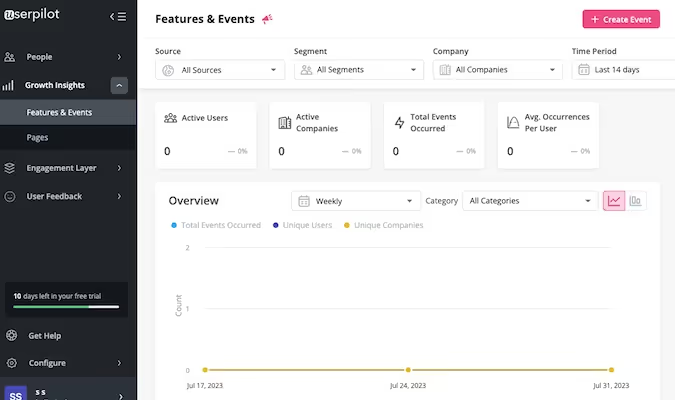
- Capterra ⭐4.6/5 (57 reviews)
- G2 ⭐4.6/5 (382 reviews)
Userpilot is a powerful onboarding and product analytics tool that targets mid-market SaaS companies.
Userpilot Features
Userpilot was initially known for the strength of its user onboarding elements, such as hotspots, tooltips, and modals.
These are all fully customizable and can be built with a minimum of coding knowledge. Thus, it's relatively straightforward for a non-technical product manager to create a product tour in an hour or two.
In the last couple of years, Userpilot has invested heavily in becoming more of a product analytics tool – an area that was previously a weakness. Their analytics will allow you to see which features are used most frequently and by which users.
More unusually, they also go as far as to show you where exactly in the feature flow your users drop off.
The company also offers sophisticated qualitative analytics through their surveying tool. This gives you the "why" to complement the "how many" that you can see from the more left-brained part of their analytics suite.
Userpilot is a complex tool, and it's not the most straightforward to learn. The more negative reviews online tend to mention the high learning curve and the lack of support if you feel stuck.
Two major features that it lacks are a product updates page and in-app announcements. You can improvise a solution to the latter using modals, but it's not a dedicated announcement feature as such.
Pricing
- From $249 per month, paid annually.
- This covers up to 2000 MAUs.
Userpilot vs Usetiful
The biggest difference between Userpilot and Usetiful is how easy each one is to adopt.
Put simply: Usetiful is much cheaper and easier to adopt, but offers less powerful features – particularly analytics.
Userpilot is chunkier and harder to learn, and also costs a lot more than Usetiful. But if you can get over that initial learning curve and have the cashflow to sustain paying for Userpilot, its onboarding features are the more powerful of the two.
In particular, Userpilot's analytics are much better than Usetiful's. Userpilot will let you segment users and then track the in-app behavior of each segment at the level of either the company or individual user in a way that Usetiful just can't handle.
Smaller companies with tighter budgets are better suited to Usetiful. Larger teams with more cash to spare and the time to learn a complex tool would be better served by Userpilot.
6. Product Fruits - almost identical to Usetiful
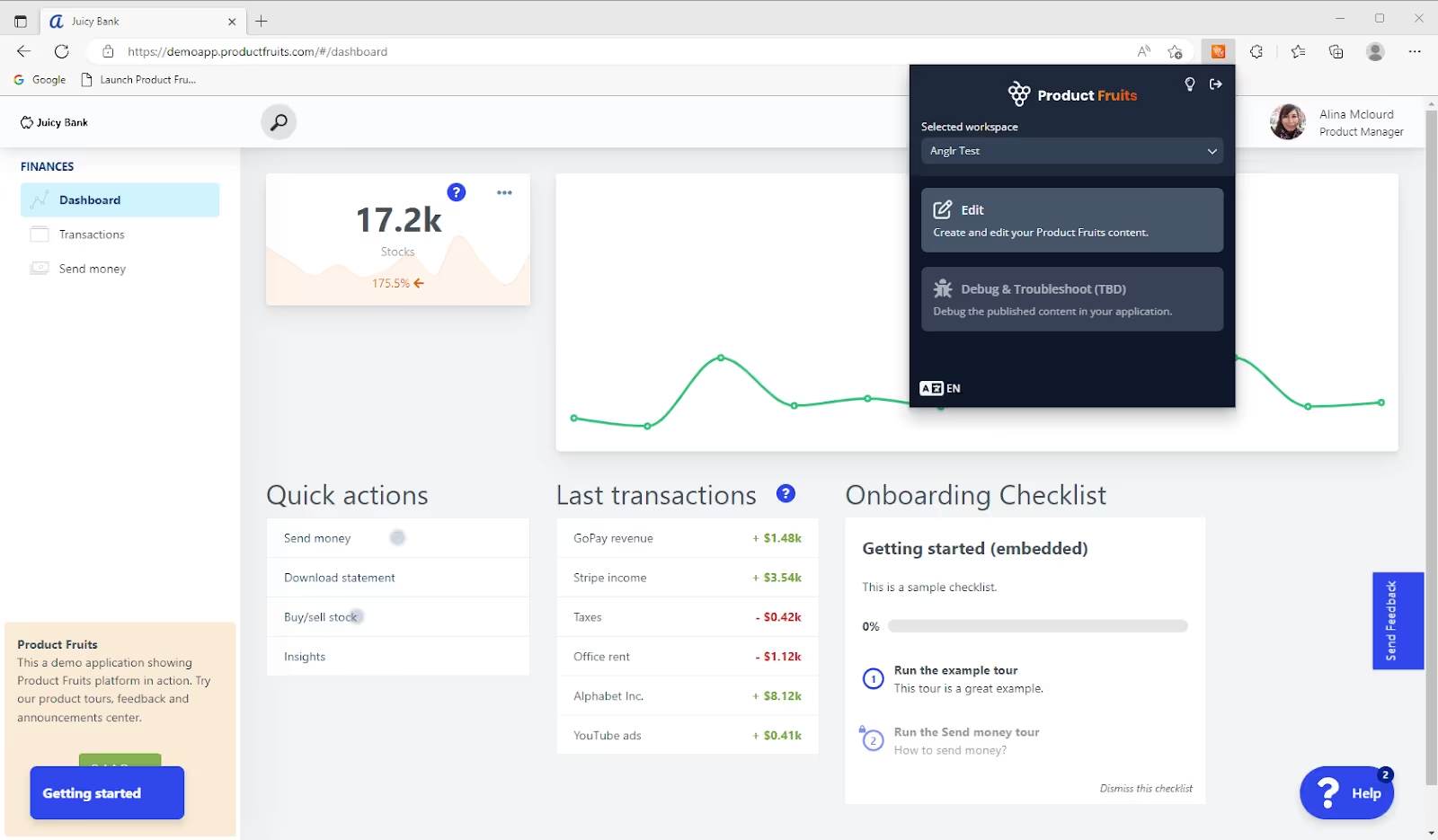
- Capterra ⭐4.8/5 (49 reviews)
- G2 ⭐4.7/5 (86 reviews)
Product Fruits is one of the newer players in the user onboarding space.
Product Fruits Features
Like its predecessors, it offers low-code product tours, hotspots, tooltips, in-app announcements, and NPS surveys.
Product Fruits has an unusual feature called a life ring button. This is basically a small widget that you can add to the bottom corner of your site. In effect, it acts like a resource center.
As a newer tool, one sometimes has the feeling that some of its features are still going through development. As such, the onboarding flows can sometimes be clunky or even break down entirely.
Like Usetiful, Product Fruit offers limited customization options for product tours. In this area, it lags behind UserGuiding and Appcues.
Its analytics are no match for some of the more established players on this list like Appcues and Userpilot, lacking the activity data that will let you draw insights at the level to really impact your business meaningfully.
Pricing
- Sliding scale based on the number of MAUs
- Starts from $69 per month, paid annually
Product Fruits vs Usetiful
Product Fruits is basically a slightly more expensive version of Usetiful.
Both tools have a solid knowledge base feature.
Both tools offer limited customization options and weak analytics that lack the detail of a Userpilot or an Appcues.
Usetiful is the better option for NPS surveys, since Product Fruits only offers those at a higher plan level – which is a little strange.
Given the two platforms are so similar and Usetiful is cheaper, I'd be inclined to recommend Usetiful over Product Fruits for most use cases. That being said, it's worth noting that neither platform is the best option for more complex onboarding cases.
7. Chameleon - some unique features, let down by bugginess

- Capterra ⭐3.9/5 (10 reviews)
- G2 ⭐4.4/5 (216 reviews)
Chameleon offers a slightly different approach to onboarding, with a large number of integrations and some features that other Usetiful competitors lack.
Unfortunately, the user experience is compromised by a buggy interface that's hard to learn and not especially affordable.
Chameleon Features
Like the other tools on this list, Chameleon lets you build tooltips, hotspots, NPS surveys, product tours, and more to boost user onboarding. It also offers a large number of integrations with other tools in your stack.
On top of this, Chameleon has a couple of unique features that the other tools don't have.
As part of Chameleon's free pricing tier, they offer a "Cmd-K search bar." This is powered by AI and allows your users to bring up relevant articles from your help center.
Another unique element Chameleon offers is the “launcher." This feature enables you to embed self-serve product announcements and onboarding menus into your product.
Unfortunately, Chameleon's tools are limited in usefulness by the lack of visual customization options. For example, in-app surveys require CSS knowledge to be customized significantly.
The technical implementation of Chameleon is also difficult and takes longer than other tools on this list, such as UserGuiding.
Pricing
- You can put a search bar inside your product for free
- Pricing is on a sliding scale based on the number of MAUs
- Plans start from $279 per month for 2000 MAUs
Chameleon vs Usetiful
When you compare these two products, the thing that strikes you the most is how much more affordable Usetiful is. If you're on a tight budget, there's no question which tool you should use.
Chameleon does have a neat AI search feature that will allow users to find relevant content quickly, and that feature is actually free. So if that's all you need, Chameleon might be a good fit.
Neither solution has especially good analytics. If analytics is your main use case, Userpilot and Appcues are better tools.
Chameleon is a lot more buggy than Usetiful and harder to pick up. So if a smooth user experience is your goal, you're better off with Usetiful.
Wrapping up
Usetiful might be a good option if you're looking for a beginner-level onboarding tool that's highly affordable.
But if you compare it against the other options on the market, it falls short in terms of analytics, limited customization and configuration capabilities, and a lack of a SOC2 certification.
The best Usetiful alternative is UserGuiding. Not only is it much cheaper than the likes of Userpilot and Appcues, it also offers features that many competitors don't have, such as product updates or the ability to analyze in-app behavior on a company-wide basis.
It's also extremely easy to install and use (check the G2 reviews if you don't believe us!), and genuinely requires no code.
So what are you waiting for? Sign up for a free UserGuiding trial today!
Frequently Asked Questions
Who should use Usetiful?
Product owners, growth managers, customer success teams, and product managers can use Usetiful and its alternatives such as UserGuiding to effectively onboard new users.
How much does Usetiful cost?
Usetiful has a free version available, but it covers only one tour and up to 2000 assists. There is a 14-day free trial, credit card required. Their plus plan costs $29/month for up to 5000 assists, and their premium plan costs $99/month for up to 20.000 assists.
What are the top alternatives to Usetiful?
The top 7 alternatives to Usetiful are UserGuiding, Shepherd.js, Appcues, Whatfix, Userpilot, Product Fruits, and Chameleon.

















.svg)
.svg)
.svg)
.svg)
.svg)

.svg)
.svg)












.svg)
.svg)




.png)
















